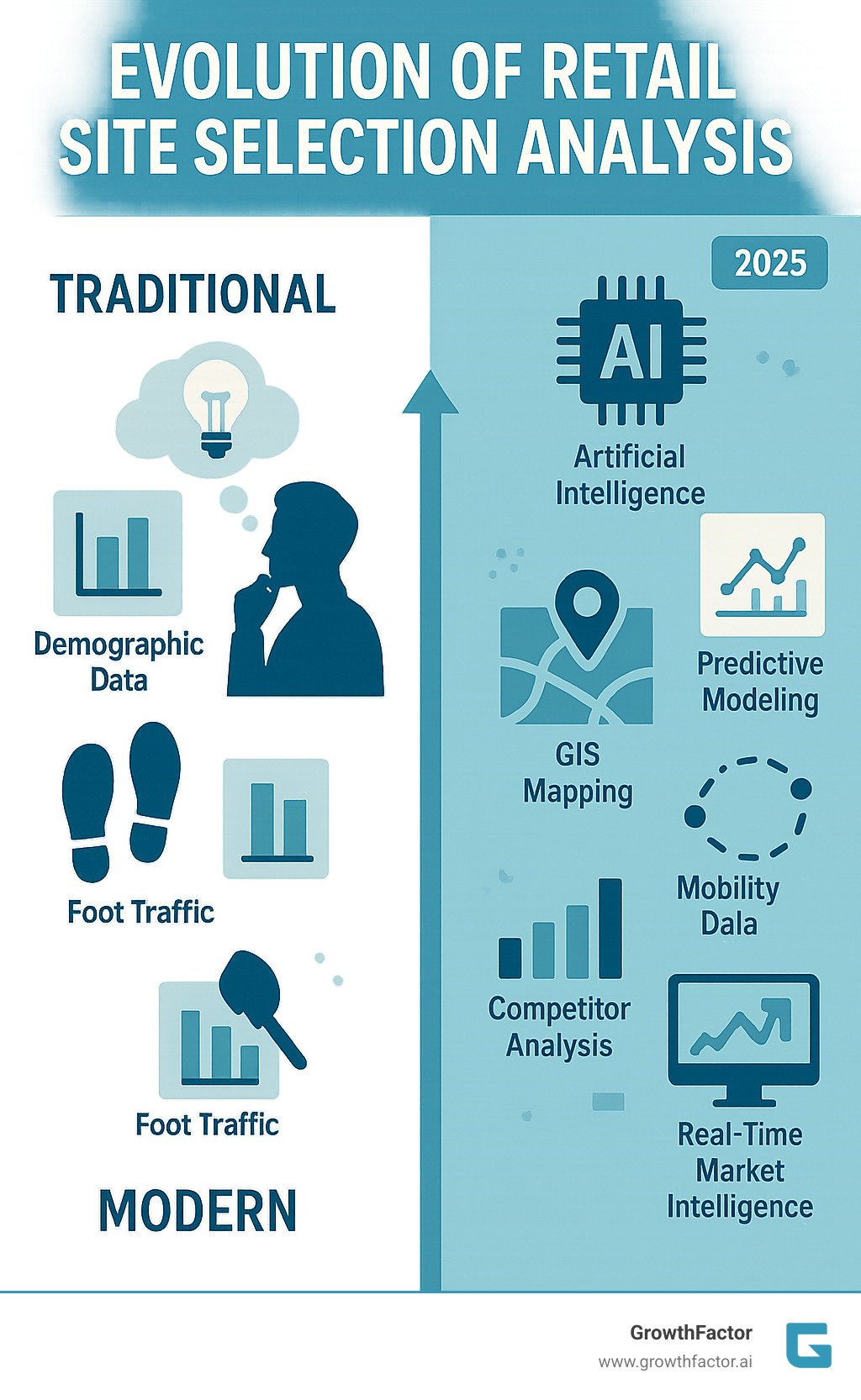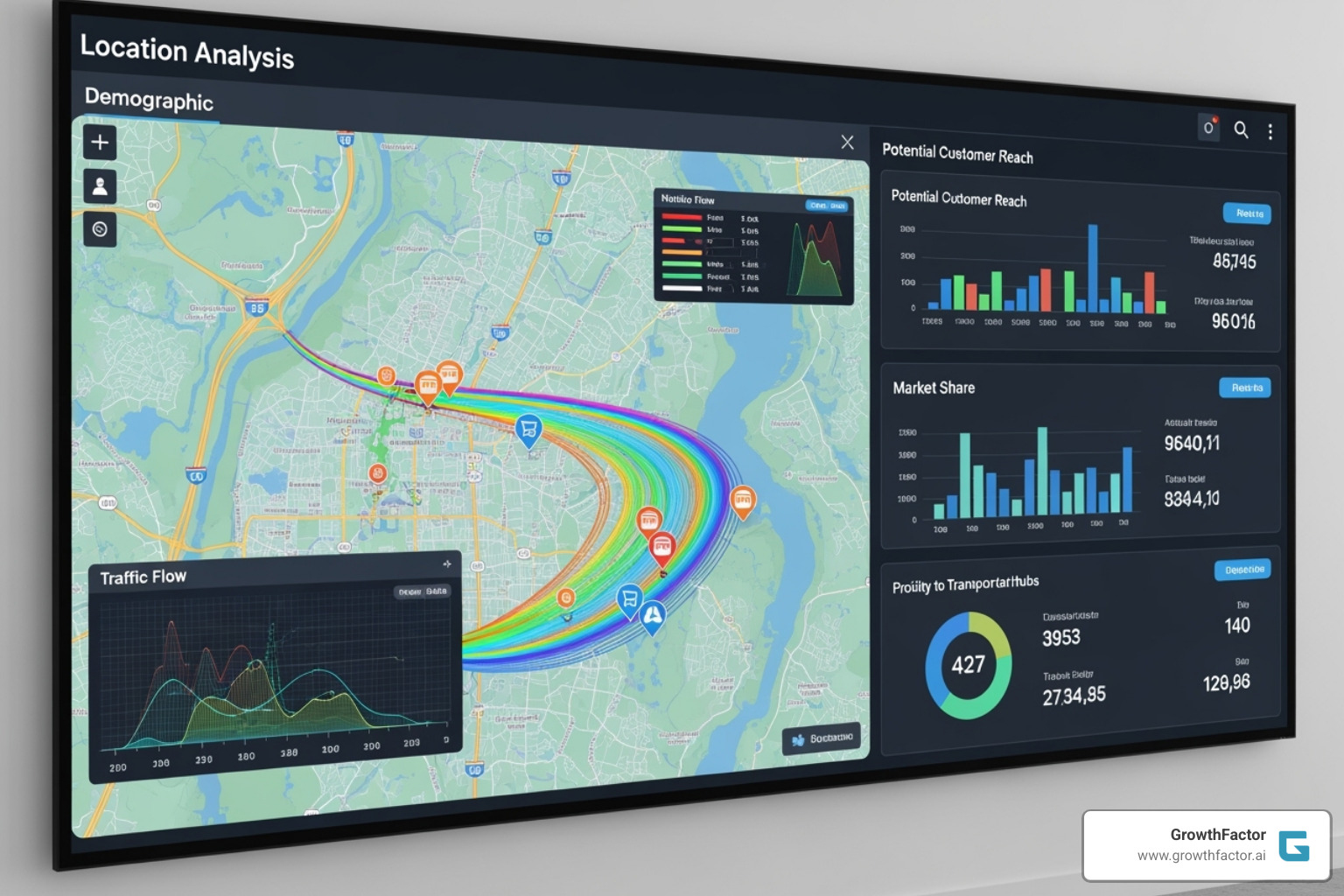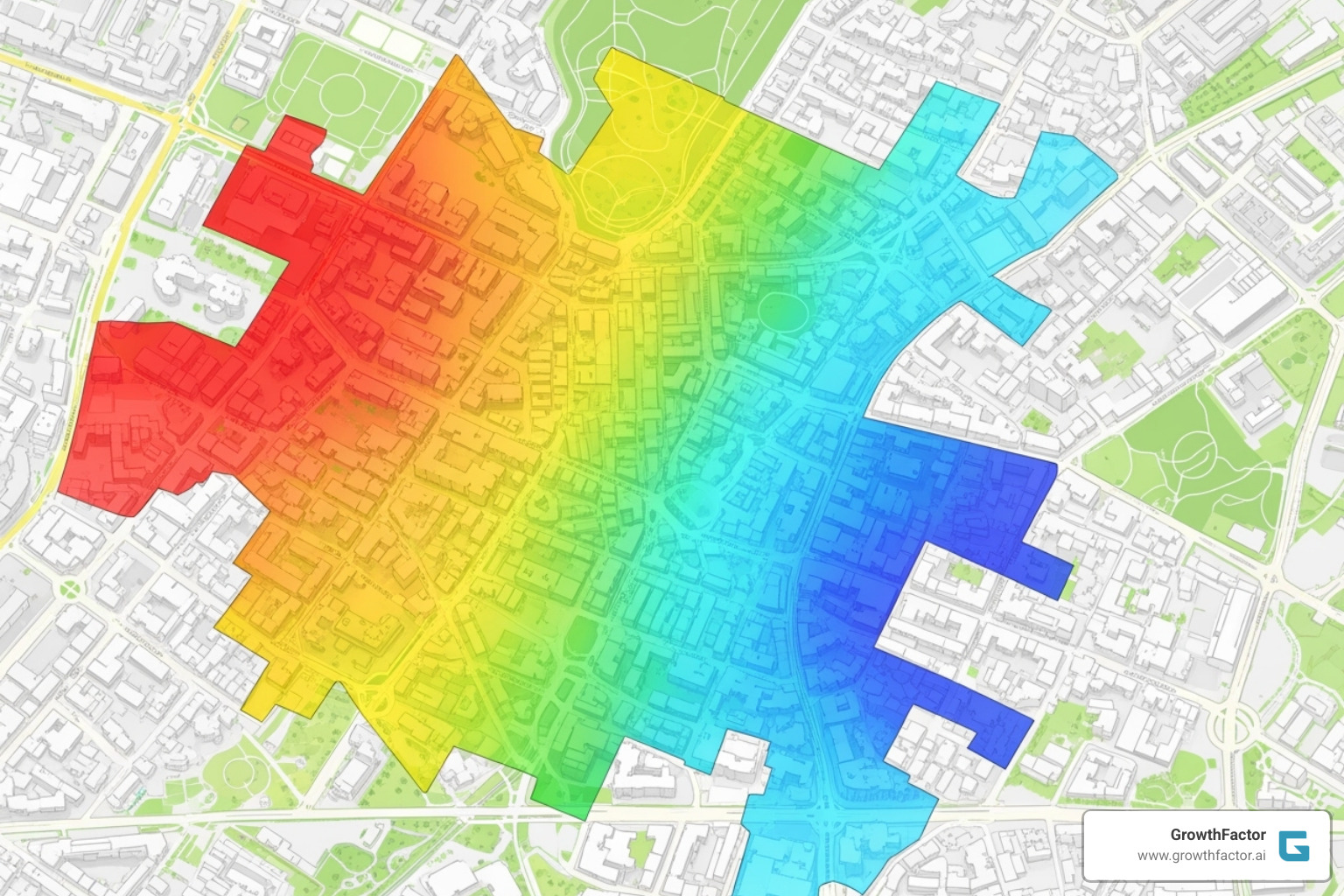The Ultimate Guide to Retail Site Selection Analysis
Why Retail Site Selection Analysis Is Critical for Business Success

Retail site selection analysis is the strategic process of choosing optimal store locations using data-driven methods to maximize profitability and minimize risk. Key components include:
Essential Analysis Areas:
- Demographics & Market Data - Age, income, lifestyle preferences of target customers
- Competition Assessment - Market saturation, competitor proximity, and complementary businesses
- Site Characteristics - Traffic patterns, visibility, accessibility, and parking availability
- Financial Viability - Real estate costs, renovation expenses, and ROI projections
- Technology Integration - GIS mapping, predictive modeling, and location intelligence tools
Despite e-commerce growth, brick-and-mortar locations still account for 82% of U.S. retail sales, making physical site selection more critical than ever.
The process has evolved from an intuition-based art to a data-driven science. Retailers now use advanced analytics and AI to evaluate sites efficiently, gaining a competitive advantage, as 70% of consumers say store location influences their decision to visit.
Retail executives face pressure to expand quickly while maintaining profitability. Manual, weeks-long evaluation processes can now be streamlined with technology platforms that analyze multiple data sources simultaneously, from foot traffic to competitor performance.
As Clyde Christian Anderson, Founder and CEO of GrowthFactor.ai, I've experienced the challenges of retail site selection analysis through my work in my family's retail business and subsequent career in investment banking. My platform has helped clients like Cavender's Western Wear triple their expansion rate while maintaining 100% accuracy in revenue projections by replacing spreadsheet-based analysis with AI-powered intelligence.

Retail site selection analysis word list:
The Core Pillars of Retail Site Selection Analysis
Successful retail expansion requires more than a great product—it demands a strategic retail site selection analysis. Finding the optimal location is the foundation for success, as a prime spot can launch a brand while a poor one can hold it back. What was once a gut-feeling decision has become a science powered by data. To understand what goes into smart site selection, we must explore its core pillars.

Understanding Your Target Market with Demographic Data
The first step in a successful retail site selection analysis is understanding your target audience through demographics and psychographics.
Demographics provide factual data like age, income levels, education, and population density. A luxury brand should target high-income areas, while a baby-focused store should seek neighborhoods with young families. Modern data tools offer thousands of variables to pinpoint the perfect customer base.
Psychographics explore the why behind consumer behavior, including lifestyle choices, values, and spending habits. A high-end jeweler thrives where luxury is valued, while a discount grocer succeeds in value-conscious communities. Aligning with local psychographics ensures your store resonates with the community. Our approach to retail location analysis always begins with this deep customer understanding.
Evaluating the Market Landscape
After defining your customer, the next step in retail site selection analysis is evaluating the surrounding market. This involves mapping the area to identify opportunities and challenges. Key questions include whether a market is saturated or if there are unmet needs—a process known as gap analysis. Analyzing competitors helps find the sweet spot: a location with high demand and manageable competition.
Nearby businesses can be beneficial through co-tenancy synergy. For example, competing home improvement stores often cluster together, creating a "shopping magnet" that draws more customers. Similarly, complementary businesses, like a smoothie shop next to a gym, can drive shared traffic. This synergy is a powerful but often overlooked factor in creating a successful retail hub. Learn more in our guide on how to choose retail location.
Assessing Accessibility, Visibility, and Site Characteristics
A location must be easy to find, access, and see. This pillar of retail site selection analysis focuses on the physical characteristics that draw customers in.
We analyze foot traffic and vehicle traffic counts to forecast potential sales. With physical stores accounting for 82% of all retail sales, visibility is paramount. A store hidden from a main road will attract fewer visitors. In fact, retail businesses visible from the road can see a 25% increase in foot traffic, highlighting the importance of a prominent location.
Convenient parking and access to public transportation are critical. If getting to your store is a hassle, customers will go elsewhere. We also assess signage rules and ease of ingress and egress (entering and exiting the site). A great location can be undermined by poor signage or difficult access. Our detailed store site selection criteria cover all these practical considerations.
Analyzing Financial Viability and Real Estate Costs
A location must be financially viable. This final pillar of retail site selection analysis involves a thorough review of all costs against the expected Return on Investment (ROI).
First, we analyze rent versus buying costs. Beyond the monthly price, we consider long-term implications like lease terms, renewal options, and exit clauses. Zoning and local ordinances are also critical, as these legal details can impose restrictions that cause costly delays or derail a project.
Beyond rent, we calculate total occupancy costs, including renovation expenses, utilities, and maintenance. Understanding both initial and ongoing expenses is key to ensuring long-term profitability.
The decision rests on ROI potential. We weigh the total cost of a location against its revenue-generating capability, using advanced sales forecasting tips for retail site selection to ensure your investment delivers a strong return. This comprehensive financial analysis is central to our real estate site selection methodology.
The Modern Approach: Data, Technology, and AI
The landscape of retail site selection analysis has transformed from an art based on intuition to a precise, data-driven science. Success now hinges on a blend of data, technology, and artificial intelligence. At GrowthFactor, we believe every location decision must be backed by robust data. Location intelligence achieves this by combining diverse datasets—demographics, consumer behavior, traffic patterns—with geospatial data. This enables powerful predictive modeling, allowing us to forecast a site's potential success with high accuracy before a lease is signed. This commitment to data-driven site selection is at the heart of what we do.

The Role of Technology in Retail Site Selection Analysis
Technology is the engine driving the modern site selection revolution, enabling the analysis and visualization of massive datasets that are impossible to manage manually. Let's look at some key players:
- GIS Software: Geographic Information Systems (GIS) are foundational for analyzing spatial data. They allow you to layer critical information—like population density, income levels, competitor locations, and traffic routes—onto a map to spot patterns and connections.
- Isochrone Maps: These tools define trade areas based on actual travel times (e.g., a 5-minute drive) rather than simple radius circles. This provides a more accurate picture of a site's accessibility and helps define realistic customer catchment areas.
- Mobility Data: Modern mobility data provides deep insights into real consumer behavior, including movement patterns, dwell times, and travel origins. This granular view is invaluable for predicting a store's potential visitor traffic.
- POI Data Integration: Integrating Points of Interest (POI) data allows for analysis of competitor distribution, identification of complementary businesses, and pinpointing areas with strong customer demand.
At GrowthFactor, our AI Agent Waldo integrates these advanced technologies, streamlining the process and allowing clients to evaluate five times more sites with greater efficiency. This is the power of AI location intelligence and AI-powered retail analytics in action.
Benefits of a Data-Driven Retail Site Selection Analysis
Adopting a data-driven approach to retail site selection analysis offers significant strategic advantages that boost your bottom line, enabling smarter, faster, and more confident expansion.
Key advantages include:
- Increased Accuracy: Analyzing thousands of data points—from demographics to mobility patterns—builds highly accurate predictive models for sales forecasting, reducing guesswork.
- Reduced Risk: Better insights lead to better decisions, minimizing the risk of investing in new stores by identifying pitfalls like market saturation before you commit capital.
- Network Optimization: A data-driven approach helps analyze potential sales "cannibalization" from existing stores, ensuring each new location strengthens the overall network.
- Maximized Store Performance: Matching the right store format to the right location, audience, and competitive landscape ensures each new store is set up for success.
- Efficiency: Our AI Agent Waldo automates much of the evaluation process, freeing up your team to assess more sites in less time and accelerate expansion. We help you end the era of spreadsheet purgatory: how AI is revolutionizing retail site selection.
A data-driven approach brings powerful benefits:
- Higher ROI on new store investments
- Better market fit for your ideal customer
- A competitive advantage through superior location strategy
- Faster expansion with reduced lead times
- Improved operational efficiency and logistics
- Improved brand visibility and customer engagement
We offer flexible plans, including our Core ($500), Growth ($1,500), and Enterprise plans, designed to fit your unique needs. We're here to help you achieve these benefits without breaking the bank!
Evolving Strategies and Common Pitfalls
The retail landscape is dynamic, constantly shaped by consumer trends, technology, and global events. Excelling in retail site selection analysis requires a forward-thinking approach that anticipates future trends and learns from common mistakes. This ensures locations are chosen not just for today's success, but for long-term viability. Our retail expansion planning software is built with this adaptability in mind.
Post-Pandemic Influences on Site Selection
The pandemic accelerated existing trends and introduced new considerations to retail site selection analysis, fundamentally changing how and where consumers shop.
A major shift was the rise of omnichannel retail, blurring the line between online and in-person shopping. Physical stores evolved into vital hubs for online order fulfillment, such as BOPIS (Buy Online, Pickup In-Store), and returns.
Curbside pickup models became standard, increasing the need for locations with easy car access and dedicated pickup zones. This is visible in redesigned drive-thrus with additional lanes to handle increased demand.
We're also seeing more mixed-use developments, where retail is blended with residential, office, and medical services. This creates vibrant communities with steady, built-in foot traffic. Initiatives like Boston’s Squares + Streets plan are changing urban zones in this way.
Dark stores, which act as fulfillment centers for online orders, are another key trend. Their site selection is focused on optimizing logistics rather than attracting foot traffic. These changes mean our retail store site selection criteria must constantly evolve.
Common Pitfalls to Avoid in the Selection Process
Even with advanced tools, it's possible to make mistakes in the retail site selection analysis process. Avoiding common pitfalls is key to making sound, long-term investment decisions.
One major pitfall is over-relying on intuition. While experience is valuable, decisions made without supporting data can lead to costly mistakes.
Another is ignoring local market knowledge. Data models are powerful, but on-the-ground insights from local brokers and community members are invaluable for validating models and understanding market nuances.
Underestimating market dynamics is also a trap. Failing to grasp competitive intensity, demand fluctuations, or a market's growth potential can lead to underperformance.
Poor lease negotiation can turn a great site into a financial burden. Unfavorable terms regarding lease length, renewal options, or exit clauses are as critical as the monthly rent.
Don't forget about neglecting hidden costs. Expenses like permits, local taxes, and ongoing maintenance can significantly impact profitability if not properly budgeted.
Finally, inadequate due diligence is a significant risk. Failing to check a building's history, verify zoning, or research future developments can lead to major unforeseen problems, like a year-long road closure blocking access to your new store.
| Factor | Poor Site Selection Choice | Strategic Site Selection Choice |
|---|---|---|
| Location Choice | Based on low rent, ignoring foot traffic or target demographics. | Based on comprehensive data, aligning with target market and high potential foot traffic. |
| Data Usage | Minimal data, relying on intuition or limited anecdotal evidence. | Extensive use of demographic, mobility, and competitive data with AI-powered analytics. |
| Market Understanding | Opens in a saturated market or an area with no demand for the product. | Identifies market gaps, synergistic co-tenants, and areas with unmet needs. |
| Financial Planning | Focuses only on base rent, overlooks renovation, utility, and maintenance costs. | Accounts for all direct and indirect costs, with clear ROI projections. |
| Long-Term Vision | No consideration for future market trends or potential urban developments. | Integrates future growth potential, zoning changes, and omnichannel strategy. |
| Outcome | Struggling sales, high operating costs, potential closure. | Strong sales, optimized operations, sustainable growth, and market leadership. |
Frequently Asked Questions about Retail Site Selection
Here are answers to some of the most common questions about retail site selection analysis, whether you're a seasoned professional or planning your first expansion.
Why is location so critical if e-commerce is growing?
While e-commerce has grown, 82% of U.S. retail sales still occur in physical stores. The role of these stores has expanded beyond transactions. They now serve as brand showcases, product experience centers, and crucial hubs for omnichannel services like BOPIS (Buy Online, Pickup In-Store), curbside delivery, and returns.
A strategic location amplifies all these functions, increasing brand visibility and customer convenience. Rather than competing with e-commerce, a well-chosen physical location strengthens a retailer's entire omnichannel strategy.
What is the difference between a trade area and a catchment area?
These terms are key in retail site selection analysis.
A trade area is the geographic region where a store draws the majority of its actual customers, typically defined by analyzing customer data (e.g., zip codes). It reflects real-world performance.
A catchment area is a theoretical boundary defined by travel time or distance (e.g., a 10-minute drive). It is used in models to estimate the potential customer base for a new location.
Trade areas help analyze current performance, while catchment areas help evaluate future potential.
How can I find data for my site selection analysis?
Quality data for retail site selection analysis can be sourced from several places:
- Public records: The U.S. Census Bureau offers free, reliable demographic data (population, age, income) for initial screening.
- Private data providers: These companies offer specialized datasets on mobility, consumer behavior, psychographics, and foot traffic for more granular insights.
- Location intelligence platforms: This is the modern solution. Platforms like GrowthFactor's aggregate diverse datasets into a single, actionable format. Our AI-improved platform combines demographic, mobility, and competitive data for comprehensive site evaluations.
Using an integrated platform eliminates time-consuming data collection and cleaning. Our AI Agent Waldo automates much of this process, allowing teams to focus on strategic analysis and evaluate more sites in less time.
Conclusion
Retail site selection analysis has evolved from a guessing game into a data-driven science, leveraging advanced analytics and AI to inform one of retail's most critical decisions. As we've explored, success rests on four core pillars: understanding the target market, evaluating the competitive landscape, assessing site accessibility, and analyzing financial viability. This holistic framework minimizes risk.
The strategic shift to data and AI offers more than efficiency. The ability to evaluate five times more sites with accuracy uncovers opportunities that manual processes miss, providing a crucial advantage in a competitive environment where speed and insight determine success.

The future of retail location strategy combines technological advances with human insight. Our AI Agent Waldo bridges this gap, automating data analysis so your team can focus on strategy. As retail evolves with omnichannel models and mixed-use developments, the right location is more important than ever. Thriving retailers will be those who merge technology with deep market understanding to create a sustainable competitive advantage.
Ready to transform your site selection process? Our advanced solutions for AI for Retail Site Selection and Report Building can empower your team to make smarter, faster decisions. Whether you're part of a growing retail chain or supporting expansion strategies, our platform is designed specifically for Site Selection for Real Estate Teams who demand both speed and accuracy in their location decisions.
The era of spreadsheet purgatory is ending. The future belongs to those who accept data-driven retail site selection analysis and the remarkable possibilities it open ups.
Citations
The human algorithm
Request a live demo
Schedule meeting
Or submit your information below and we'll be in touch to schedule.


